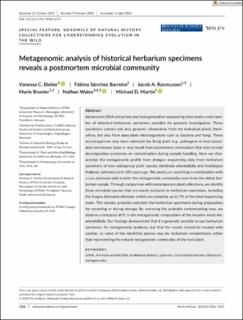| dc.contributor.author | Bieker, Vanessa Carina | |
| dc.contributor.author | Sánchez Barreiro, Fatima | |
| dc.contributor.author | Rasmussen, Jacob Agerbo | |
| dc.contributor.author | Brunier, Marie | |
| dc.contributor.author | Wales, Nathan | |
| dc.contributor.author | Martin, Michael David | |
| dc.date.accessioned | 2021-02-08T14:34:01Z | |
| dc.date.available | 2021-02-08T14:34:01Z | |
| dc.date.created | 2020-04-26T21:22:15Z | |
| dc.date.issued | 2020 | |
| dc.identifier.citation | Molecular Ecology Resources. 2020, 20 1206-1219. | en_US |
| dc.identifier.issn | 1755-098X | |
| dc.identifier.uri | https://hdl.handle.net/11250/2726662 | |
| dc.description.abstract | Advances in DNA extraction and next-generation sequencing have made a vast number of historical herbarium specimens available for genomic investigation. These specimens contain not only genomic information from the individual plants themselves, but also from associated microorganisms such as bacteria and fungi. These microorganisms may have colonized the living plant (e.g., pathogens or host-associated commensal taxa) or may result from postmortem colonization that may include decomposition processes or contamination during sample handling. Here we characterize the metagenomic profile from shotgun sequencing data from herbarium specimens of two widespread plant species (Ambrosia artemisiifolia and Arabidopsis thaliana) collected up to 180 years ago. We used blast searching in combination with megan and were able to infer the metagenomic community even from the oldest herbarium sample. Through comparison with contemporary plant collections, we identify three microbial species that are nearly exclusive to herbarium specimens, including the fungus Alternaria alternata, which can comprise up to 7% of the total sequencing reads. This species probably colonizes the herbarium specimens during preparation for mounting or during storage. By removing the probable contaminating taxa, we observe a temporal shift in the metagenomic composition of the invasive weed Am. artemisiifolia. Our findings demonstrate that it is generally possible to use herbarium specimens for metagenomic analyses, but that the results should be treated with caution, as some of the identified species may be herbarium contaminants rather than representing the natural metagenomic community of the host plant. | en_US |
| dc.language.iso | eng | en_US |
| dc.publisher | John Wiley & Sons | en_US |
| dc.rights | Navngivelse 4.0 Internasjonal | * |
| dc.rights.uri | http://creativecommons.org/licenses/by/4.0/deed.no | * |
| dc.title | Metagenomic analysis of historical herbarium specimens reveals a postmortem microbial community | en_US |
| dc.type | Peer reviewed | en_US |
| dc.type | Journal article | en_US |
| dc.description.version | publishedVersion | en_US |
| dc.source.pagenumber | 1206-1219 | en_US |
| dc.source.volume | 20 | en_US |
| dc.source.journal | Molecular Ecology Resources | en_US |
| dc.identifier.doi | 10.1111/1755-0998.13174 | |
| dc.identifier.cristin | 1808123 | |
| dc.relation.project | Notur/NorStore: NS9819K | en_US |
| dc.relation.project | Notur/NorStore: NN9449K | en_US |
| dc.description.localcode | This is an open access article under the terms of the Creative Commons Attribution License, which permits use, distribution and reproduction in any medium, provided the original work is properly cited. © 2020 The Authors. | en_US |
| cristin.ispublished | true | |
| cristin.fulltext | original | |
| cristin.qualitycode | 1 | |

